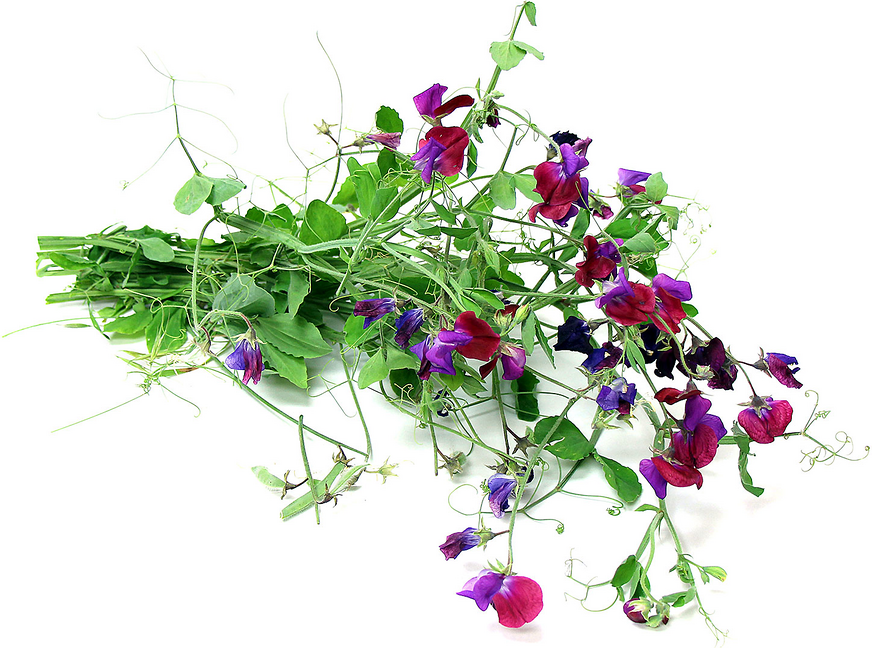


Foraged Wild Sweet Peas
Estimated Inventory, lb : 0
Description/Taste
Wild Sweet Pea is a climbing vine that can extend several meters in length. These plants feature trailing stems adorned with small, green, lance-shaped leaflets with pointed tips. They bloom in vivid shades of bright pink, lavender, and red, and their leaflets eventually develop into pea pods. Initially green, these pods mature to a brown or black hue. When opened, the pods reveal a pale green to off-white interior, containing several spherical seeds that are green when young and darken as they age. The blossoms of the Wild Sweet Pea emit a grape-like scent, though the peas themselves are odorless. While opinions vary on the edibility of Wild Sweet Peas, those who have sampled the plant describe its flowers and young tendrils as having a sweet, grassy, vegetal flavor. The pods are slightly more fibrous than commercial sugar snap or snow peas, but the peas inside are very similar in taste, whether consumed fresh or dried.
Seasons/Availability
Wild Sweet Peas bloom from March to August.
Current Facts
Wild Sweet Peas, botanically known as Lathyrus vestitus, are part of the Fabaceae family and the Lathyrus genus. The name "Lathyrus" comes from the Greek "lathyros," an ancient term for pea. Commonly referred to as Pacific Pea, Bolander's Pea, Beach Pea, and San Diego Pea, this plant is a vital component of the chaparral ecosystem, particularly in areas recovering from wildfires. Its rapidly spreading roots play a critical role in stabilizing and anchoring soil, preventing erosion in fire-cleared regions. Wild Sweet Pea excels in nitrogen fixation, a process where symbiotic bacteria in its roots convert atmospheric nitrogen into a form plants can use. This capability is especially beneficial in the nutrient-poor, rocky, and sandy soils of chaparral regions, enhancing soil fertility and supporting not only Wild Sweet Pea but other nearby plant life. The flowers of the plant are pollinated by bees, while butterflies use the plant for its nectar. Various beetles, caterpillars, and herbivorous animals feed on the leaves of the Wild Sweet Pea plant.
Nutritional Value
Wild Sweet Pea belongs to the Lathyrus genus, which encompasses a mix of both edible and non-edible species. While there are no specific records confirming the toxicity of this particular species, the seeds and other parts of many plants within the Lathyrus genus are known to contain a toxic amino acid. In small amounts, this amino acid is harmless, and historically, the seeds of several Lathyrus species, including Wild Sweet Peas, have been consumed as a nutritious component of diets. The toxicity in these species can often be mitigated by specific cooking methods. Since there isn't much information on the safety of eating Wild Sweet Peas, it's best to be cautious about consuming them.
Applications
Wild Sweet Peas have been gathered from their natural habitats for local consumption as both a food and a medicine. Some people suggest that their raw seeds are edible, and their young leaves and stems can be cooked and eaten as greens. Decoctions have been made from the roots to be used as an emetic and a general remedy to treat internal injuries. However, some species within the Lathyrus genus are known to cause lathyrism, a serious neurological condition. Lathyrism can lead to paralysis and muscle atrophy if consumed in large quantities or over an extended period. Other symptoms may include back pain, followed by weakness and stiffness in the legs and progressive locomotor incoordination.
Ethnic/Cultural Info
The Miwok tribe of California's Central Valley incorporated Wild Peas into their diets. They resided in the foothills of the Sierra Mountains and along the Sacramento River and its delta. They structured their society into tribelets—small clusters of villages ranging from 100 to 500 individuals. In their cultural framework, everything and everyone was classified as belonging either to water or to land. During spring, the Miwok harvested green plants to consume fresh. Wild Peas were commonly eaten as part of their diet alongside other greens like columbine, milkweed, and sheep sorrel. These greens were often served as an accompaniment to acorn soup.
Geography/History
Wild Sweet Pea is indigenous to western North America, primarily thriving in the forests, woodlands, and chaparral of California. This plant is favored for its low maintenance and dry shade tolerance, making it an ideal choice for gardeners looking to adorn fences or trellises. While many species within the Lathyrus genus originally hail from Eurasia, the Wild Sweet Pea is native to a region extending from Oregon to Baja California. It has successfully adapted to coastal areas, forest edges, and open fields, which facilitates its spread across diverse landscapes. Although predominantly a wild species, the Wild Sweet Pea is also cultivated in gardens, particularly within its native range.
Recipe Ideas
Recipes that include Foraged Wild Sweet Peas. One
| The Heart of New England |
|
Sautéed Pea Tendrils with Garlic Scapes |
| Indian Kitchen: filled with spices and love |
|
Peas, Carrot and Beans Poriyal |
| What's Gaby Cooking |
|
Spring Pea Farro Salad |




